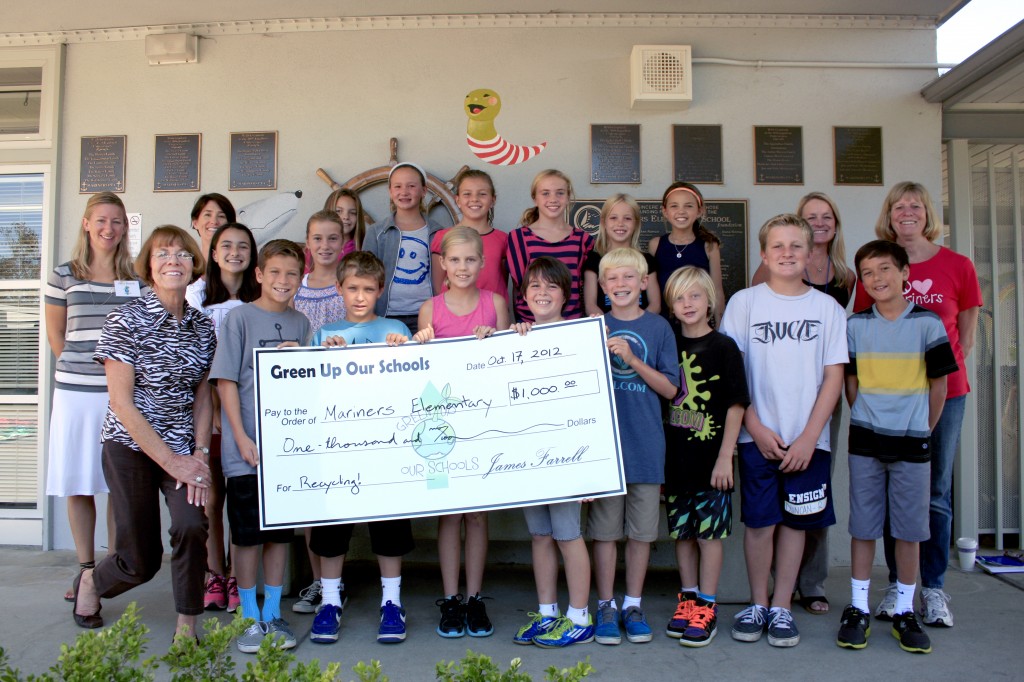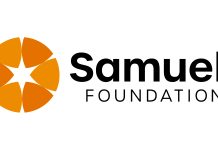
Being green isn’t easy, but students at Mariners Elementary School are willing to do all the hard work necessary to be just that.
The student Green Team was presented with a $1,000 check on Oct. 17 for being accepted into the Green Up Our Schools grant program. The school will also receive $500 during the next two years.
The grant money will most likely be used to buy a big magnetic sign to hang on the big recycling bin, listing all the items that are allowed, and a new wheeled transport cart, so parents can easily haul their recyclables from their car to the bin, and Green Team t-shirts for the students, said Mariners principal Pam Coughlin.
The school’s large recycling bin gets filled up about once a month and the school gets about $300 each time.
That money is used toward teacher training, supplies, extra-curricular activities, and other resources.
Green Up Our Schools, a 501(c)(3), required for the application that Mariners create a recycling and waste reduction plan and pick two goals per year during the three-year program, said program coordinator, Patty Breech.
Their first goal this year is to swap out the non-recyclable Ziploc baggies or bigger, disposable sized bags that a lot of parents were using to hold snacks for reusable snack bags for kindergarteners.
The second goal for the year is to send home a Tupperware container with all students for the zero waste student lunch.
“These goals we’re asking for, we want the students to be the drivers behind that,” Breech said. “They’re the ones who are going to be going out and educating everybody about these snack bags or how to pack a zero waste lunch.”
They will have to measure how many students are using the zero waste lunch over the school year, said Green Team committee member, Lisa Li.
The other requirement for application into the grant program is to have an active student Green Team on campus, Breech said, which Mariners has had for three years.
The program also asks the participating schools to do a trash assessment, by pulling a sample of trash and seeing if any of it should have been recycled, Breech explained.
The fourth graders examined their trash recently and found that about 20 percent of it was recyclable materials. They will do it again at the end of the year to see their progress. They will continue this pattern for the following two years in the program.
That is a good starting point, most schools start around 40 to 50 percent, Breech added, that means Mariners’ students will have to work harder to lower that number, but it shouldn’t be too difficult with the kids carefully watching the waste bin.
“What happens is, when the kids see even one sheet of paper in the trash, they get so mad,” and then re-emphasize the importance of recycling, Breech said. “It’s a really good way to just get the kids fired up about this.”
They are very passionate about recycling, they all agreed.
“I think people should recycle more because people at home just sit on the couch and throw everything away,” said fourth grader Reese Bodas, 9, a class representative for the Green Team. “They waste a lot.”
It’s important to recycle, she said, and not keep creating more trash.
Another fourth grade Green Team class representative, Peyton Hlista, 9, said she saves up her recyclables at home and then brings them into the classroom to include toward the school’s goal.
Encouraging parents to bring in their own recycling is an important part of the program, said Pat McLaughlin, third grade teacher, student council representative, and Green Team lead advisor. Stephanie Parole, fourth grade teacher, is also a Green Team advisor.
The students have also been teaching the teachers and reminding them, often, about recycling and saving energy.
“And for teachers, when you’re drinking a coke can, you need to think that you can recycle that,” said the school’s energy commissioner, fifth grader Jack Kalatschan, 11.
Kalatschan and other Green Team members will visit all the classrooms periodically to check in and see how well each class is doing.
“I have to go around school and see what we need to save and try to save more energy or else I won’t achieve my goal,” of exceeding last year’s total energy savings, he said.
They can do things like putting computers on sleep mode during recess, turning off the lights when they can, re-use and recycle paper, he said. On bright, sunny days they can also turn off half the lights in the room and still have plenty of illumination for working. Or something as simple as turning off the coffee pot immediately after having the last cup, as one teacher found out a couple years ago.
It’s the first year working with the Green Up Our Schools program, second year having the large recyclable bin, and third year working with Southern California Edison in an energy savings program.
For the Edison program, the district calculates how much money the school saves on energy costs over the entire year and the school gets half that amount.
Coughlin recently received the school’s check from last year, a total of $2,352.50.
The Green Team kids get to come up with ideas and vote on what to spend the money on. Coughlin has suggested an energy efficient dishwasher.
Mariners has also been chosen as a mentor school, so students at other NMUSD schools can learn how to save more energy.
A simple encouragement to other students often helps, Kalatschan said: “Go green!”
Visit greenupourschools.org for more information about the Green Up Our Schools grant program.




